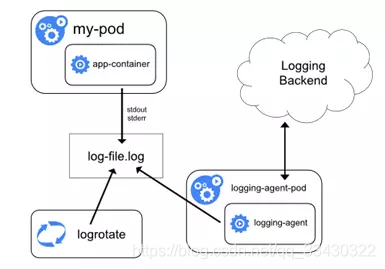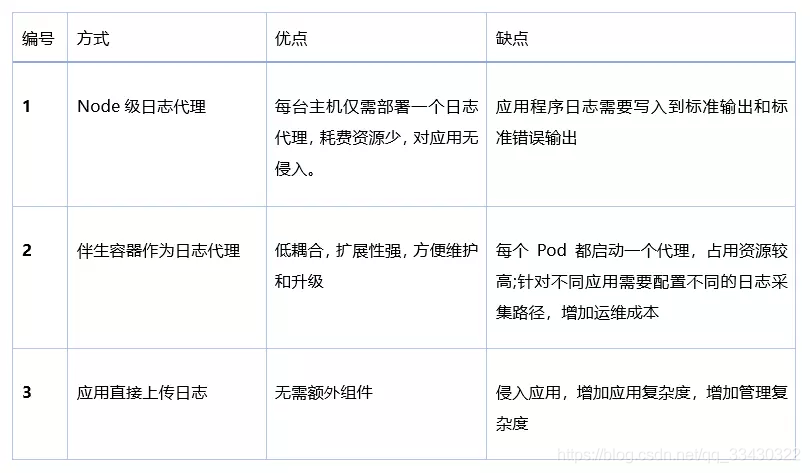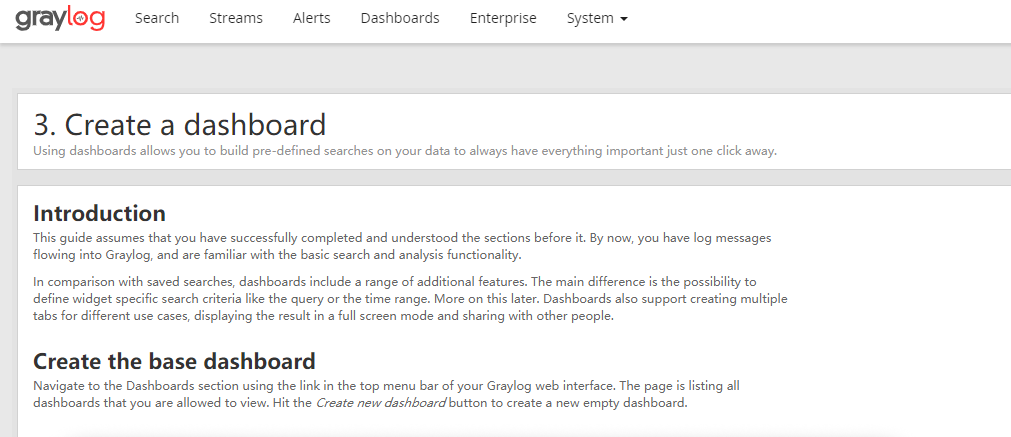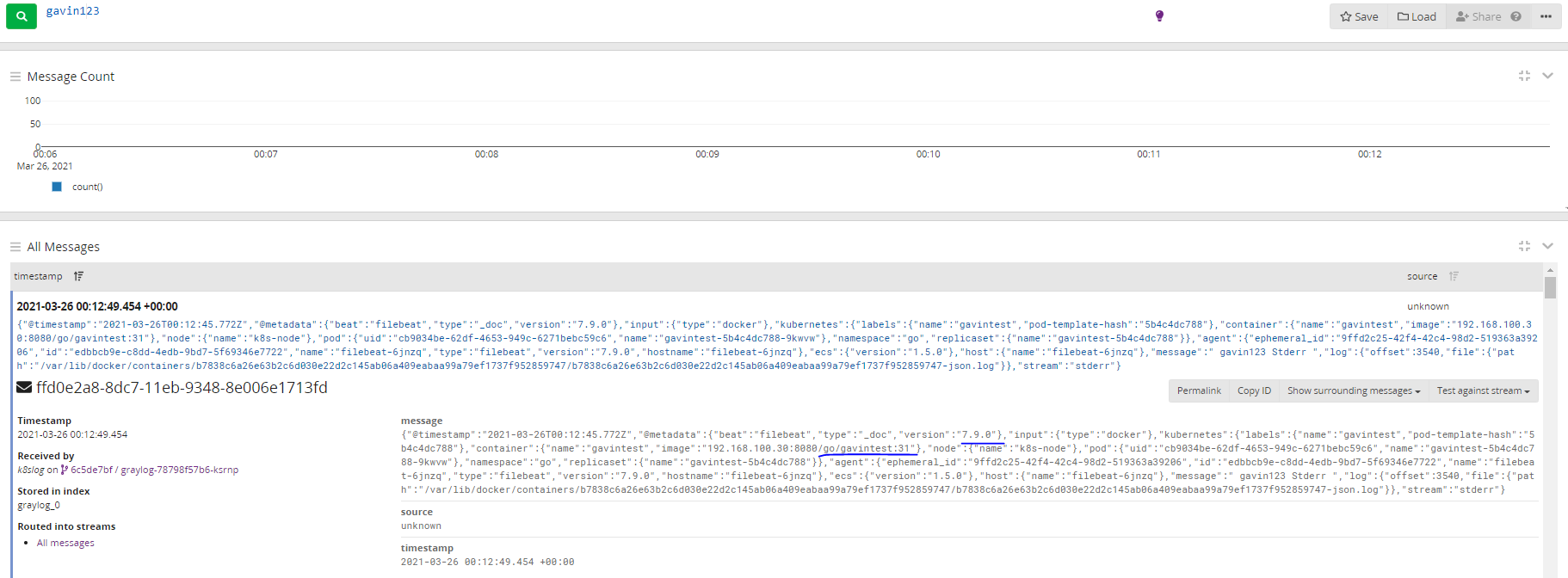使用ELK+Filebeat架构,还需要明确Filebeat采集K8S集群日志的方式。
方式1:Node级日志代理
在每个节点(即宿主机)上可以独立运行一个Node级日志代理,通常的实现方式为DaemonSet。用户应用只需要将日志写到标准输出,Docker 的日志驱动会将每个容器的标准输出收集并写入到主机文件系统,这样Node级日志代理就可以将日志统一收集并上传。另外,可以使用K8S的logrotate或Docker 的log-opt 选项负责日志的轮转。

Docker默认的日志驱动(LogDriver)是json-driver,其会将日志以JSON文件的方式存储。所有容器输出到控制台的日志,都会以*-json.log的命名方式保存在/var/lib/docker/containers/目录下。对于Docker日志驱动的具体介绍,请参考官方文档。另外,除了收集Docker容器日志,一般建议同时收集K8S自身的日志以及宿主机的所有系统日志,其位置都在var/log下。

所以,简单来说,本方式就是在每个node上各运行一个日志代理容器,对本节点/var/log和 /var/lib/docker/containers/两个目录下的日志进行采集,然后汇总到elasticsearch集群,最后通过kibana展示。
方式2:伴生容器(sidecar container)作为日志代理
创建一个伴生容器(也可称作日志容器),与应用程序容器在处于同一个Pod中。同时伴生容器内部运行一个独立的、专门为收集应用日志的代理,常见的有Logstash、Fluentd 、Filebeat等。日志容器通过共享卷可以获得应用容器的日志,然后进行上传。

方式3:应用直接上传日志
应用程序容器直接通过网络连接上传日志到后端,这是最简单的方式。

对比

相对来说,方式1在业界使用更为广泛,并且官方也更为推荐。因此,最终我们采用ELK+Filebeat架构,并基于方式1,如下:
1.创建es.yaml 【kubectl apply -f ./es.yaml】
apiVersion: apps/v1 kind: StatefulSet metadata: name: elasticsearch namespace: kube-system labels: k8s-app: elasticsearch spec: serviceName: elasticsearch selector: matchLabels: k8s-app: elasticsearch template: metadata: labels: k8s-app: elasticsearch spec: containers: - image: docker.elastic.co/elasticsearch/elasticsearch:7.9.0 name: elasticsearch resources: limits: cpu: 1 memory: 1Gi requests: cpu: 0.5 memory: 500Mi env: - name: "discovery.type" value: "single-node" - name: ES_JAVA_OPTS value: "-Xms512m -Xmx2g" ports: - containerPort: 9200 name: db protocol: TCP volumeMounts: - name: elasticsearch-data mountPath: /usr/share/elasticsearch/data volumeClaimTemplates: - metadata: name: elasticsearch-data spec: storageClassName: "nfs" accessModes: [ "ReadWriteOnce" ] resources: requests: storage: 2Gi --- apiVersion: v1 kind: Service metadata: name: elasticsearch namespace: kube-system spec: clusterIP: None ports: - port: 9200 protocol: TCP targetPort: db selector: k8s-app: elasticsearch
2.创建kibana.yaml【kubectl apply -f ./kibana.yaml】
apiVersion: apps/v1 kind: Deployment metadata: name: kibana namespace: kube-system labels: k8s-app: kibana spec: replicas: 1 selector: matchLabels: k8s-app: kibana template: metadata: labels: k8s-app: kibana spec: containers: - name: kibana image: kibana:7.3.1 resources: limits: cpu: 1 memory: 500Mi requests: cpu: 0.5 memory: 200Mi env: - name: ELASTICSEARCH_HOSTS value: http://elasticsearch:9200 ports: - containerPort: 5601 name: ui protocol: TCP --- apiVersion: v1 kind: Service metadata: name: kibana namespace: kube-system spec: type: NodePort ports: - port: 5601 protocol: TCP targetPort: ui nodePort: 30056 selector: k8s-app: kibana
3.现在有一个nginx程序, 我们采用方式2来收集日志 nginx-dm.yaml 【 kubectl apply -f ./nginx-dm.yaml】
apiVersion: apps/v1beta1 kind: Deployment metadata: name: php-demo namespace: kube-system spec: replicas: 1 selector: matchLabels: project: www app: php-demo template: metadata: labels: project: www app: php-demo spec: imagePullSecrets: - name: registry-pull-secret containers: - name: nginx image: lizhenliang/nginx-php ports: - containerPort: 80 name: web protocol: TCP resources: requests: cpu: 0.5 memory: 256Mi limits: cpu: 1 memory: 1Gi livenessProbe: httpGet: path: /status.html port: 80 initialDelaySeconds: 20 timeoutSeconds: 20 readinessProbe: httpGet: path: /status.html port: 80 initialDelaySeconds: 20 timeoutSeconds: 20 volumeMounts: - name: nginx-logs mountPath: /usr/local/nginx/logs - name: filebeat image: docker.elastic.co/beats/filebeat:7.9.0 args: [ "-c", "/etc/filebeat.yml", "-e", ] resources: limits: memory: 500Mi requests: cpu: 100m memory: 100Mi securityContext: runAsUser: 0 volumeMounts: - name: filebeat-config mountPath: /etc/filebeat.yml subPath: filebeat.yml - name: nginx-logs mountPath: /usr/local/nginx/logs volumes: - name: nginx-logs emptyDir: {} - name: filebeat-config configMap: name: filebeat-nginx-config --- apiVersion: v1 kind: ConfigMap metadata: name: filebeat-nginx-config namespace: kube-system data: filebeat.yml: |- filebeat.inputs: - type: log paths: - /usr/local/nginx/logs/access.log # tags: ["access"] fields: app: www type: nginx-access fields_under_root: true setup.ilm.enabled: false setup.template.name: "nginx-access" setup.template.pattern: "nginx-access-*" output.elasticsearch: hosts: ['elasticsearch.kube-system:9200'] index: "nginx-access-%{+yyyy.MM.dd}"
等pod启动起来 我们可以进入pod 查看日志如下:

在kibana创建index nginx-access*然后访问如下:

4.现在我们来用方式1来拉日志 filebeat-k8s.yaml 【 kubectl apply -f ./filebeat-k8s.yaml 】
apiVersion: v1 kind: ConfigMap metadata: name: filebeat-config namespace: kube-system labels: k8s-app: filebeat kubernetes.io/cluster-service: "true" data: filebeat.yml: |- filebeat.config: inputs: # Mounted `filebeat-inputs` configmap: path: ${path.config}/inputs.d/*.yml # Reload inputs configs as they change: reload.enabled: false modules: path: ${path.config}/modules.d/*.yml # Reload module configs as they change: reload.enabled: false # To enable hints based autodiscover, remove `filebeat.config.inputs` configuration and uncomment this: #filebeat.autodiscover: # providers: # - type: kubernetes # hints.enabled: true output.elasticsearch: hosts: ['${ELASTICSEARCH_HOST:elasticsearch}:${ELASTICSEARCH_PORT:9200}'] --- apiVersion: v1 kind: ConfigMap metadata: name: filebeat-inputs namespace: kube-system labels: k8s-app: filebeat kubernetes.io/cluster-service: "true" data: kubernetes.yml: |- - type: docker containers.ids: - "*" processors: - add_kubernetes_metadata: in_cluster: true --- apiVersion: apps/v1 kind: DaemonSet metadata: name: filebeat namespace: kube-system labels: k8s-app: filebeat kubernetes.io/cluster-service: "true" spec: selector: matchLabels: k8s-app: filebeat template: metadata: labels: k8s-app: filebeat kubernetes.io/cluster-service: "true" spec: serviceAccountName: filebeat terminationGracePeriodSeconds: 30 containers: - name: filebeat image: docker.elastic.co/beats/filebeat:7.9.0 args: [ "-c", "/etc/filebeat.yml", "-e", ] env: - name: ELASTICSEARCH_HOST value: elasticsearch - name: ELASTICSEARCH_PORT value: "9200" securityContext: runAsUser: 0 # If using Red Hat OpenShift uncomment this: #privileged: true resources: requests: cpu: 10m memory: 100Mi limits: cpu: 50m memory: 500Mi volumeMounts: - name: config mountPath: /etc/filebeat.yml readOnly: true subPath: filebeat.yml - name: inputs mountPath: /usr/share/filebeat/inputs.d readOnly: true - name: data mountPath: /usr/share/filebeat/data - name: varlibdockercontainers mountPath: /var/lib/docker/containers readOnly: true volumes: - name: config configMap: defaultMode: 0600 name: filebeat-config - name: varlibdockercontainers hostPath: path: /var/lib/docker/containers - name: inputs configMap: defaultMode: 0600 name: filebeat-inputs # data folder stores a registry of read status for all files, so we don't send everything again on a Filebeat pod restart - name: data hostPath: path: /var/lib/filebeat-data type: DirectoryOrCreate --- apiVersion: rbac.authorization.k8s.io/v1beta1 kind: ClusterRoleBinding metadata: name: filebeat subjects: - kind: ServiceAccount name: filebeat namespace: kube-system roleRef: kind: ClusterRole name: filebeat apiGroup: rbac.authorization.k8s.io --- apiVersion: rbac.authorization.k8s.io/v1beta1 kind: ClusterRole metadata: name: filebeat labels: k8s-app: filebeat rules: - apiGroups: [""] # "" indicates the core API group resources: - namespaces - pods verbs: - get - watch - list --- apiVersion: v1 kind: ServiceAccount metadata: name: filebeat namespace: kube-system labels: k8s-app: filebeat
在kibanan 创建 filebeat-7.9.0-* 索引

5.我们修改 nginx-dm.yaml文件之创建pod, log改在到nfs上去 【 kubectl apply -f ./nginx-dm.yaml】
apiVersion: apps/v1beta1 kind: Deployment metadata: name: php-demo namespace: kube-system spec: replicas: 1 selector: matchLabels: project: www app: php-demo template: metadata: labels: project: www app: php-demo spec: imagePullSecrets: - name: registry-pull-secret containers: - name: nginx image: lizhenliang/nginx-php ports: - containerPort: 80 name: web protocol: TCP resources: requests: cpu: 0.5 memory: 256Mi limits: cpu: 1 memory: 1Gi livenessProbe: httpGet: path: /status.html port: 80 initialDelaySeconds: 20 timeoutSeconds: 20 readinessProbe: httpGet: path: /status.html port: 80 initialDelaySeconds: 20 timeoutSeconds: 20 volumeMounts: - name: nginx-logs mountPath: /usr/local/nginx/logs volumes: #定义一组挂载设备 - name: nginx-logs #定义一个挂载设备的名字 #persistentVolumeClaim: 使用PVC模式 #claimName: nfs-pvc nfs: #这里是nfs挂载 server: 192.168.100.11 #nfs服务器的ip或者域名 path: "/nfs/jenkins" #nfs服务配置的挂载目录
我这里把pod的日志写道nfs上【如果日志写的不频繁这是可以的】然后在创建k8s-log.yaml把nfs的日志写道es 【 kubectl apply -f ./k8s-log.yaml】
apiVersion: v1 kind: ConfigMap metadata: name: k8s-logs-filebeat-config namespace: kube-system data: filebeat.yml: | filebeat.inputs: - type: log paths: - /var/log/messages fields: app: k8s type: module fields_under_root: true setup.ilm.enabled: false setup.template.name: "k8s-module" setup.template.pattern: "k8s-module-*" output.elasticsearch: hosts: ['elasticsearch.kube-system:9200'] index: "k8s-module-%{+yyyy.MM.dd}" --- apiVersion: apps/v1 kind: DaemonSet metadata: name: k8s-logs namespace: kube-system spec: selector: matchLabels: project: k8s app: filebeat template: metadata: labels: project: k8s app: filebeat spec: containers: - name: filebeat image: docker.elastic.co/beats/filebeat:7.9.0 args: [ "-c", "/etc/filebeat.yml", "-e", ] resources: requests: cpu: 10m memory: 100Mi limits: cpu: 50m memory: 500Mi securityContext: runAsUser: 0 volumeMounts: - name: filebeat-config mountPath: /etc/filebeat.yml subPath: filebeat.yml - name: k8s-logs mountPath: /var/log/messages volumes: - name: k8s-logs nfs: server: 192.168.100.11 path: "/nfs/jenkins" - name: filebeat-config configMap: name: k8s-logs-filebeat-config
在kibanan 创建 k8s-module-* 索引

6.如果我们自己的程序日志需要用到方案1 该如何实现:需要将我们的日志写道 错误输出里面【标准输出默认是不会显示到屏幕的】,也就是我们可以通过 kubectl logs gavintest-5f4d66bc58-67d4x -n go 可以在屏幕查看到日志信息, 方式1才能手机此信息
修改程序如下[ 我这里是beego项目]

用jenkins发版,然后访问,查看pod日志

查看 kibana日志


备注:有些时候直接下载镜像很慢,可以先下载下来: 我曾先用 docker.elastic.co/kibana/kibana:7.9.0 结果发现kibana 端口拒绝, 后来换一个镜像
docker pull docker.elastic.co/beats/filebeat:7.9.0 docker pull docker.elastic.co/elasticsearch/elasticsearch:7.9.0 #docker pull docker.elastic.co/kibana/kibana:7.9.0 docker pull lizhenliang/nginx-php docker save -o filebeat:7.9.0.tar docker.elastic.co/beats/filebeat:7.9.0 docker save -o elasticsearch:7.9.0.tar docker.elastic.co/elasticsearch/elasticsearch:7.9.0 #docker save -o kibana:7.9.0.tar docker.elastic.co/kibana/kibana:7.9.0 docker save -o kibana:7.3.1.tar kibana:7.3.1 docker save -o nginx-php.tar lizhenliang/nginx-php docker load -i filebeat:7.9.0.tar docker load -i elasticsearch:7.9.0.tar #docker load -i kibana:7.9.0.tar docker load -i kibana:7.3.1.tar docker load -i nginx-php.tar
GrayLog
我这里已经有es了,那我就直安装mongodb和graylog了
新建mongodb.yaml 【kubectl apply -f mongodb.yaml】
apiVersion: apps/v1 kind: StatefulSet metadata: name: mongo namespace: kube-system labels: k8s-app: mongo spec: serviceName: mongo selector: matchLabels: k8s-app: mongo template: metadata: labels: k8s-app: mongo spec: containers: - image: mongo:latest name: mongo ports: - containerPort: 27017 protocol: TCP volumeMounts: - name: mongo-data mountPath: /data/db volumeClaimTemplates: - metadata: name: mongo-data spec: storageClassName: "nfs" accessModes: [ "ReadWriteMany" ] resources: requests: storage: 1Gi --- apiVersion: v1 kind: Service metadata: name: mongo namespace: kube-system spec: ports: - port: 27017 protocol: TCP targetPort: 27017 selector: k8s-app: mongo
如果遇到changing ownership of '/data/db': Operation not permitted错误, 我这里的原因是
NFS默认是squash_all模式,但是要想使用NFS目录,将目录映射到docker容器中,必须要配置成no_root_squash模式才行,否则root用户无权限使用nfs的volume来映射docker容器中的目录!!!
no_root_squash模式:是登入 NFS 主机使用分享目录的使用者,如果是 root 的话,那么对于这个分享的目录来说,他就具有 root 的权限!这个项目『极不安全』,不建议使用!
编辑vim /etc/exports 文件在指定位置添加 no_root_squash
如:/nfs/jenkins *(rw,sync,no_subtree_check,no_root_squash)
然后重启nfs服务 systemctl restart nfs-kernel-server
2新建graylog.yaml 【kubectl apply -f graylog.yaml】
apiVersion: apps/v1 kind: Deployment metadata: name: graylog namespace: kube-system labels: k8s-app: graylog spec: replicas: 1 selector: matchLabels: k8s-app: graylog template: metadata: labels: k8s-app: graylog spec: containers: - name: graylog image: graylog/graylog:4.0.3 env: - name: GRAYLOG_PASSWORD_SECRET value: somepasswordpepper - name: GRAYLOG_ROOT_PASSWORD_SHA2 value: 8c6976e5b5410415bde908bd4dee15dfb167a9c873fc4bb8a81f6f2ab448a918 - name: GRAYLOG_HTTP_EXTERNAL_URI value: http://192.168.100.11:30003/ - name: GRAYLOG_ELASTICSEARCH_HOSTS value: http://elasticsearch:9200 - name: GRAYLOG_MONGODB_URI value: mongodb://mongo:27017/graylog ports: - containerPort: 9000 - containerPort: 12201 - containerPort: 5044 --- apiVersion: v1 kind: Service metadata: name: graylog namespace: kube-system spec: type: NodePort selector: k8s-app: graylog ports: - name: "9000" port: 9000 targetPort: 9000 nodePort: 30003 - name: "12201" port: 12201 targetPort: 12201 nodePort: 30004 - name: "5044" port: 5044 targetPort: 5044 nodePort: 30005
访问http://192.168.100.11:30003/ 用户名和密码 都是admin,【我这里es是7.9,我graylog曾用过3.3 结果不兼容,所以改为最新的4.0.3,大家启动gray也可以看看日志】

filebeat
首先我们建一个filebeat的输入【看到这里的端口是5044了吧】,然后修改采集日志的文件k8s-log.yaml

k8s-log.yaml 【kubectl apply -f k8s-log.yaml]
apiVersion: v1 kind: ConfigMap metadata: name: k8s-logs-filebeat-config namespace: kube-system data: filebeat.yml: | filebeat.inputs: - type: log paths: - /var/log/messages/*.log fields: app: k8s type: module fields_under_root: true setup.ilm.enabled: false setup.template.name: "k8s-module" setup.template.pattern: "k8s-module-*" #output.elasticsearch: #hosts: ['elasticsearch.kube-system:9200'] #index: "k8s-module-%{+yyyy.MM.dd}" output: logstash: hosts: - 192.168.100.11:30005 --- apiVersion: apps/v1 kind: DaemonSet metadata: name: k8s-logs namespace: kube-system spec: selector: matchLabels: project: k8s app: filebeat template: metadata: labels: project: k8s app: filebeat spec: containers: - name: filebeat image: docker.elastic.co/beats/filebeat:7.9.0 args: [ "-c", "/etc/filebeat.yml", "-e", ] resources: requests: cpu: 10m memory: 100Mi limits: cpu: 50m memory: 500Mi securityContext: runAsUser: 0 volumeMounts: - name: filebeat-config mountPath: /etc/filebeat.yml subPath: filebeat.yml - name: k8s-logs mountPath: /var/log/messages volumes: - name: k8s-logs nfs: server: 192.168.100.11 path: "/nfs/jenkins" - name: filebeat-config configMap: name: k8s-logs-filebeat-config
查看结果 【需要把前面的nginx-dm.yam 文件运行起来, 往nfs写日志】

kafka
这里我的日志 从filebeat->kafka->graylog,新建graylog的input 【为了防止干扰 我们把向前的日志文件干掉 kubectl delete -f k8s-log.yaml 和 kubectl delete -f nginx-dm.yaml】

修改filebeat-k8s.yaml 使日志输出到kafka而不是es [kubectl apply -f filebeat-k8s.yaml]
apiVersion: v1 kind: ConfigMap metadata: name: filebeat-config namespace: kube-system labels: k8s-app: filebeat kubernetes.io/cluster-service: "true" data: filebeat.yml: |- filebeat.config: inputs: # Mounted `filebeat-inputs` configmap: path: ${path.config}/inputs.d/*.yml # Reload inputs configs as they change: reload.enabled: false modules: path: ${path.config}/modules.d/*.yml # Reload module configs as they change: reload.enabled: false # To enable hints based autodiscover, remove `filebeat.config.inputs` configuration and uncomment this: #filebeat.autodiscover: # providers: # - type: kubernetes # hints.enabled: true #output.elasticsearch: #hosts: ['${ELASTICSEARCH_HOST:elasticsearch}:${ELASTICSEARCH_PORT:9200}'] output.kafka: enabled: true hosts: ["192.168.100.30:9092"] topic: "k8s" --- apiVersion: v1 kind: ConfigMap metadata: name: filebeat-inputs namespace: kube-system labels: k8s-app: filebeat kubernetes.io/cluster-service: "true" data: kubernetes.yml: |- - type: docker containers.ids: - "*" processors: - add_kubernetes_metadata: in_cluster: true --- apiVersion: apps/v1 kind: DaemonSet metadata: name: filebeat namespace: kube-system labels: k8s-app: filebeat kubernetes.io/cluster-service: "true" spec: selector: matchLabels: k8s-app: filebeat template: metadata: labels: k8s-app: filebeat kubernetes.io/cluster-service: "true" spec: serviceAccountName: filebeat terminationGracePeriodSeconds: 30 containers: - name: filebeat image: docker.elastic.co/beats/filebeat:7.9.0 args: [ "-c", "/etc/filebeat.yml", "-e", ] env: - name: ELASTICSEARCH_HOST value: elasticsearch - name: ELASTICSEARCH_PORT value: "9200" securityContext: runAsUser: 0 # If using Red Hat OpenShift uncomment this: #privileged: true resources: requests: cpu: 10m memory: 100Mi limits: cpu: 50m memory: 500Mi volumeMounts: - name: config mountPath: /etc/filebeat.yml readOnly: true subPath: filebeat.yml - name: inputs mountPath: /usr/share/filebeat/inputs.d readOnly: true - name: data mountPath: /usr/share/filebeat/data - name: varlibdockercontainers mountPath: /var/lib/docker/containers readOnly: true volumes: - name: config configMap: defaultMode: 0600 name: filebeat-config - name: varlibdockercontainers hostPath: path: /var/lib/docker/containers - name: inputs configMap: defaultMode: 0600 name: filebeat-inputs # data folder stores a registry of read status for all files, so we don't send everything again on a Filebeat pod restart - name: data hostPath: path: /var/lib/filebeat-data type: DirectoryOrCreate --- apiVersion: rbac.authorization.k8s.io/v1beta1 kind: ClusterRoleBinding metadata: name: filebeat subjects: - kind: ServiceAccount name: filebeat namespace: kube-system roleRef: kind: ClusterRole name: filebeat apiGroup: rbac.authorization.k8s.io --- apiVersion: rbac.authorization.k8s.io/v1beta1 kind: ClusterRole metadata: name: filebeat labels: k8s-app: filebeat rules: - apiGroups: [""] # "" indicates the core API group resources: - namespaces - pods verbs: - get - watch - list --- apiVersion: v1 kind: ServiceAccount metadata: name: filebeat namespace: kube-system labels: k8s-app: filebeat



参考:
https://hub.kubeapps.com/charts/stable/graylog#!
https://blog.51cto.com/liujingyu/2537488?source=dra
https://blog.csdn.net/qq_33430322/article/details/89237140
https://blog.51cto.com/14143894/2438188?source=dra